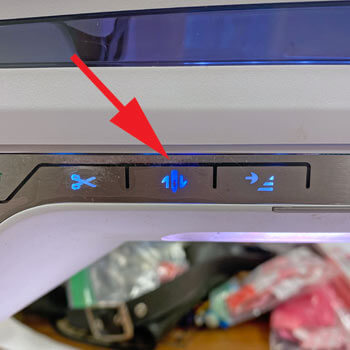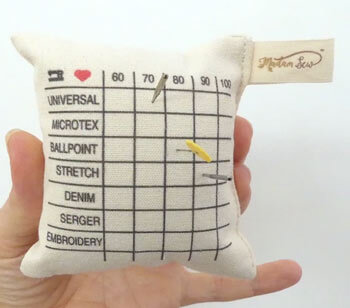Chain Piecing Quilt Blocks: Where Precision Meets Bobbin Chicken
This post contains affiliate links, for which I receive compensation.
There's nothing makes a quilter happier than humming along, feeding pairs of patches through her sewing machine.
The constant, hypnotic whir of the machine, the up-and-down of the needle, the pile of freshly stitched patches that stack up, is somehow soothing to my soul.
It's a cozy, peaceful quilting bubble.
You, too?
If so, then let's add chain piecing quilt blocks to your quilting repertoire.

To make it easy to find the information you need, use these links to navigate this article:
- The disadvantages — believe it or not, there are a few
- Specialty tools that make the job easier
- Chain piecing versus strip piecing? What's the difference?
What is chain piecing?
Simply put, chain piecing is sewing pieces together without cutting the threads between them.
This speeds up the piecing process significantly. Simply feed the next pair under the presser foot and continue sewing.
That's all there is to it.

Sewing machine setup
This technique falls under traditional piecing, so there aren't any real changes to make to your machine's set-up.
Though there's a feature to take advantage of if you've got it.
'Needle stop down' is helpful
 Needle stop down is a quick click on this Viking sewing machine
Needle stop down is a quick click on this Viking sewing machineIt's like having an extra hand to hold things. Like the name says, when you stop sewing, the needle automatically stops in the down position, piercing and holding your fabric patches.
Some older sewing machines don't have this feature.
Check your instruction manual to see if you can tap the presser an extra time to bring the needle down. If not, keep this feature on your list of must-haves for your next machine.
Yep, if you take to quilting, I see another sewing machine in your future.
What stitch length to use to piece quilt blocks?
For traditional piecing, I use a 2.0 mm stitch length. For paper piecing, I reduce that to 1.5 mm.
Helpful Tip
You've had so many things to buy to start quilting. Some seamed—😁—pretty generic.
Your seam ripper, for instance.
Ideally, you want a seam ripper with a point small enough that it fits under a stitch without having to force it.
What are the benefits of chain piecing?
- Fast way to piece blocks. You feed one pair after another into your sewing machine.
- Saves thread by not cutting it between blocks. This seems like such a silly thing, but if you've taken the plunge and purchased a quality thread (like Aurifil or Masterpiece), let's be frugal where we can.
- Sets you into an efficient rhythm—your sewing groove. There's nothing more Zen-like than being able to rhythmically feed patches into your sewing machine. Cathartic. Restorative. Beautiful.
- Efficient pressing. If all your patches are alike, don't cut the threads at your sewing machine. Take the chain to your iron, and press a whole string assembly line style. This works whether the seams are pressed open or to one side. After pressing, then cut the threads.

Are there any disadvantages when you chain piece?
There are two things to be aware of as you stitch.
- Thread tangles. When your chain of stitched patches gets really long, the joining threads can get tangled. The simple fix is to cut the threads with your scissor. It's but a momentary problem.
- Sewing patches together wrong…and needing to un-sew. If you've got 30 pairs of patches to sew together, you really don't want to make a mistake. Again, there's a simple fix. Sew one pair of patches together. Open it up and check that it's correct. All that's left is to make sure the rest are lined up the same.
Take a minute before you start and do a Sewing Test to fine tune your 1/4" seam allowance to the fabrics you'll be working on. It's a good habit to get into to minimize ripping out seams that are too big or too small.
Do you need any special tools for chain piecing?
A sharp scissor that fits nicely in your hand is always, well…handy. And it's probably already in your sewing kit.
If you want to improve your scissor collection, consider adding a pair of Perfect Scissors by Karen K. Buckley to your toolkit. Super sharp blades that are serrated to grab the threads, with finger holes big enough to get even the little sausages on my hands through them. :D
 My go-tos are the silver Gingher thread snips and the blue-handled Perfect Scissors.
My go-tos are the silver Gingher thread snips and the blue-handled Perfect Scissors.Thread snips are an efficient choice. With their compact blades, you're not having to make any big movements with your hands as you cut the thread chain. You can even hold on to them as you stitch.
Talk about having your snips right where you need them!
If you've got a pile of patches to separate, a chain piecing thread cutter with a stationary blade is also an alternative, so you can easily move from patch to patch efficiently.
Below are two different versions of the tool. Click on the image for more information and reviews, and/or to purchase.
Can you chain piece when you paper piece?
As long as a seam runs from one edge of your paper pattern to another edge—it doesn't end somewhere in the middle—you can use this simple technique. Look for the opportunity with the last patch in a unit or block.
In this strip of paper pieced half square triangles, every single seam runs from one side of the pattern to the other.
 These were stitched starting with the left-most triangle
These were stitched starting with the left-most triangleHere, the last three seams in a pair of Flying Geese (AKA Arrowhead quilt block) can be paper pieced—the seam that adds the second Goose (Patch 3, the 3's under the presser foot) and the two final #4 Sky patches.
 It's easy to see how the last three seams are candidates for chain piecing in this picture.
It's easy to see how the last three seams are candidates for chain piecing in this picture.Above, it's easy to see that the seams between the #1 and #2 patches ARE NOT candidates for chain piecing. Both seams stop in the middle of the pattern.
The last three seams in a Flying Geese Trio or quartet can be chain pieced, too.
 Chain piecing the last three seams in these Flying Geese makes this step in the quilt go so much faster.
Chain piecing the last three seams in these Flying Geese makes this step in the quilt go so much faster.Chain Piecing versus Strip Piecing—What's the difference?
Chain piecing and strip piecing are two different techniques that are very useful in quilting, but it can definitely be confusing for a beginning quilter.
Allow me to clarify:
Strip piecing refers to sewing strips of fabric together first along the long edge.
 Since I'm making SCRAPPY 4-patches, I want a lot of variety so I'm using shorter strips of my 'dark' fabric with a longer background strip.
Since I'm making SCRAPPY 4-patches, I want a lot of variety so I'm using shorter strips of my 'dark' fabric with a longer background strip.After pressing, we cut them into shapes like squares, rectangles, or triangles. This allows you to work efficiently with long strips rather than cutting many small squares or pieces.
Chain piecing refers to the process of sewing pieces together without cutting the thread between them to speed up assembly. For example, chaining together a series of patchwork squares or triangles one right after the other.
 All that's needed for chain piecing is a seam that runs from one side of the block or unit to the other. Paper piecing (top) and traditional (bottom)
All that's needed for chain piecing is a seam that runs from one side of the block or unit to the other. Paper piecing (top) and traditional (bottom)The main difference is chain piecing joins existing cut pieces end-to-end, while strip piecing sews strips side-by-side before doing additional cutting.
 Sewn strips are subcut into patches after strip piecing
Sewn strips are subcut into patches after strip piecingChain piecing is all about efficiency and not stopping to cut threads between small units or blocks. Strip piecing first makes strip sets to streamline the cutting step later.
Two useful techniques with two different purposes. I hope this has clarified the differences for you.
When a quilter continues sewing—either with intent or in ignorance—with a nearly empty bobbin thread without stopping to replace it. (My friend Sandy plays this A LOT!)
 Not a lot of thread left on the bobbin. Will I be able to stitch this last pile?
Not a lot of thread left on the bobbin. Will I be able to stitch this last pile?If she's playing with intent, the quilter guesstimates how much thread is left on the bobbin and stitches right until it runs out completely. (Drat, that beeper on my machine that doesn't alert me soon enough! 😊)
Playing "bobbin chicken" allows quilters to avoid stopping mid-project to rewind bobbins, but has an element of risk each time the bobbin nears empty.
So in essence, "bobbin chicken" describes pushing one's luck sewing with an almost empty bobbin just to avoid an inconvenient thread change.
 So close, but no banana! The thread ran out at the blue arrow.
So close, but no banana! The thread ran out at the blue arrow.Makes so much sense, right?
If she's playing in ignorance, well…
Being so blissfully lost in a flow of creativity isn't such a bad thing, now, is it?
Surfacing from a cozy, peaceful quilting bubble, only to find you've quilted an entire block—or 23—with an empty bobbin.
Oh, the price of quilting nirvana!
All that's left is to do the thing.
The rhythmic hum of the sewing machine, the hypnotic growing pile of pieced patches—chain piecing delivers this quilting nirvana in the easiest way possible.
Experienced quilters swear by this handy time-saving trick. Now you can achieve the same satisfying results.
Happy Chain Piecing quilt blocks!
















